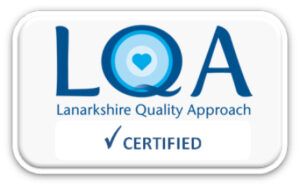Eating for Children with Autism
Information for patients
NHS Lanarkshire Dietetic Department
PIL.EATAUT.22_08742.L
This leaflet is for parents and carers of children with Autism to help them encourage their child to eat a range of foods that will keep them healthy.
Do’s and Dont’s
- Never force your child to eat, this can make problems worse.
- Do not ask your child what they want to eat. Offer the full range of foods that your child does eat but try to avoid giving them the same meal 2 days in a row.
- Do not let your child help themselves to foods and avoid letting them have more than 3 snacks per day.
- Provide 3 meals and 3 snacks daily. Visual aids such as a meal plan using pictures can help your child understand when, where and what they will be eating.
- Do not comment about uneaten food, keep calm and pretend you don’t mind them not eating.
- If the child never sits down with you to eat, show them that you have a pleasant and relaxed time eating. Joining you, even for a short time, is progress. Initially there should be no expectation to eat when sitting with you if they don’t normally.
- Aim to finish main meals in 20-30 minutes. Don’t let the first course last longer than 20 minutes.
- Offer pudding, even if they don’t eat the first course. All food is good food, but avoid using pudding as the reward.
- Give your child Healthy Start vitamin drops until they are 4 years. Once they are older, give them one of the various children’s multivitamin and mineral supplements available from supermarkets and chemists.
Hints and Tips
- Encourage your child to get involved with food, for example helping unpack the shopping, helping with meal preparation, serving food to others, clearing plates after meals.
- Encourage messy play if your child has difficulty tolerating certain textures. Start with things they are happy to touch, for example dry rice or beans; progress to wet foods, for example jelly or yoghurt. The aim is to have fun and for your child to get messy with NO expectation to eat during this time.
- If your child will only tolerate one food on their plate, try offering 2 or 3 foods on a divided plate or use a large plate allowing space between the foods. You may find you need to use a different plate for each food, but don’t worry as it is what they eat that is most important, not how they eat it.
If you think your child has constipation, reflux or any other health problems, treating this may help improve their appetite.
Ask your GP, health visitor or paediatrician for advice if you are worried about their health.
Once you have introduced some of the changes above you can begin offering new foods to your child.
Children with autism are often most comfortable eating a specific food, however it is important you continue to give foods that are slightly different and not always an exact match to their preferred food. This can help improve the range of foods that are acceptable to them.
Below are some examples of ways parents have introduced new foods to their child’s diet.
- Jack is 8 years old
- He only ate medium sliced white bread. Like many children on the autism spectrum, Jack is very rigid and will not try new foods. To help Jack increase his range of foods his parents took a step-by-step approach:
- White medium sliced > white thick sliced > 50:50 sliced > wholegrain > toast > crackers> oat cakes
- Once Jack accepted a new food in the chain, his parents gave it to him regularly. Eventually he regularly ate all the foods in the chain.
- Amy is 5 years old
- She only ate first stage, fruit puree baby food. Mum first tried different brands of fruit puree.
- Next, while Amy watched, mum added a tiny amount (½ teaspoon) of fruit she had pureed; mum gradually increased the amount until Amy would eat a bowl of homemade fruit puree. Mum gradually blended the fruit less and less until Amy got used to lumps and was able to eat mashed fruit.
- Paul is 10 years old
- He only ate dry toast for breakfast and chicken dippers for lunch and tea. Mum was concerned that he seemed hungry and, over time, she gradually increased his portions from 4 to 10 chicken dippers. Paul began to put on too much weight.
- Mum then reduced his portion to 5 chicken dippers (a more appropriate portion size for his age) and gave him a slice of toast along with it. Paul stopped gaining too much weight and accepted 2 different foods on his plate at meal times.
Is your child underweight or losing weight without meaning to?
- It may not be appropriate to work on expanding their range of foods until they are within a healthy weight range. Having enough energy for growth is more important.
- Encourage your child to eat larger amounts of their preferred foods. Offer these regularly at 3 meals and 3 snacks each day.
- Encourage more of the calorie rich foods from their preferred foods in favour of lower calorie foods, for example yoghurt rather than fruit for dessert.
- If they take butter, margarine, cheese spread or peanut butter, etc, spread these thickly on bread, toast or crackers.
- Increase cheese, oil and butter in cooking as tolerated.
- Offer milk, milk shakes or smoothies with meals and snacks.
- Ask your GP or paediatrician to refer your child to a dietitian
Is your child overweight or gaining weight too quickly?
- Reduce and limit screen time, including time spent on tablet, iPad, computer or television.
- Encourage increased physical activity; for example, walk to school, walk the dog, walk to the park, bounce on a trampoline, swimming, etc.
- Do not let your child help themselves to snacks; keep to a regular routine of 3 meals and 2-3 snacks each day. A visual timetable can help.
- Encourage foods that are low in energy, for example fruit and vegetables and restrict foods that are high in sugar and/or fat, for example sweetened drinks, crisps, sweets, biscuits and chips.
- Avoid using foods to reward good behaviour or to encourage communication skills.
- Give your child age appropriate portion sizes, even if they are only eating one food item at a meal.
- Encourage more than one food at each meal rather than increasing the quantity of one food, for example 4 chicken nuggets and a slice of bread or spoonful of sweet corn, rather than 10 chicken nuggets.
Helpful links
Further information from National Autistic Society
For specific information about visual aids see
http://www.autism.org.uk/about/strategies/visual-supports.aspx
Pub. date: April 2022
Review date: April 2024
Issue No: 01
Reference: PIL.EATAUT.22_08742.L
If you need this information in another language or format, please e-mail:




